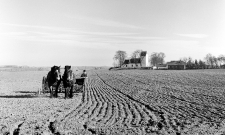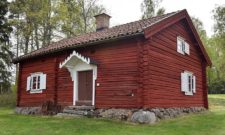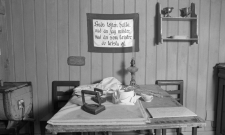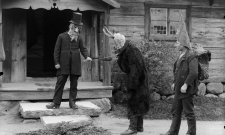Shop our historical maps

Jan
Oscar Montelius (1843-1921) writes about the pagan midwinter festival celebrated by the Swedes' ancestors sometime in January or February. From Svenska fornminnesföreningens tidskrift, volume 9, 1894.
In the world of nature, light and darkness, heat and cold, are in constant struggle with each other, as in mankind good struggles with evil for dominion. From time immemorial the sun, the knight of light, the implacable enemy of darkness and cold, has also been the object of a worship which has been perpetuated in various forms from one tribe to another, right up to the present day.
The farther north one goes, the more important becomes the blurring of summer light and winter darkness, the more powerful an impression is made on men's minds when the sun victoriously chases the darkness, or when, at other times, the light is forced to recede farther and farther away.
This impression was stronger than now in the childhood days of our family, at a time when we had not yet learned to read the book of nature in such a way as to be able to calculate in advance the course of the sun on the hills, the changes of the days and years. And the impression was strongest in our regions, near the polar circle, where the winter is so long that, as our ancestors did, they were accustomed to count time not in years, but in winters.
Since the bright summer of the north has all too soon departed, the days grow shorter and the sun more powerless. The powers of darkness are spreading their dominion, and their complete victory over sun, light and warmth seems near. But at last the tide turns, the sun regains its strength and begins its triumphant course again. Then, in the midst of the chill of winter, the pagan northerner celebrated his great midwinter festival, to express his joy at the birth of the new year's sun.
One of the oldest writers on our region, Procopius, who was born in Palestine, but was acquainted with our brothers fighting in Italy in the fifth century, had heard of this feast.
On the island of Thule in the far north, by which he means the Scandinavian island of the lions, the sun did not rise for forty days at the time of the winter solstice. So at least men who had come from that island had told him. After the inhabitants, it was further said, had lived thirty-five days in darkness, they would, according to ancient custom, send up to the highest mountains scouts, who, when they saw the sun from the mountain-tops, would announce it to the inhabitants below, whereupon they, though still in darkness, would joyfully make a feast to celebrate the return of the sun. This was the greatest festival of the Thule.
But the sun gives not only light, but also good annual growth. Therefore, according to the youth's legend, Odin commanded the Swedes at the midwinter festival to bleed for good fortune in the new year, the beginning of which was reckoned from that feast.
The thought of this material advantage gradually obscured the memory of the original reason for the celebration of Midwinter, just as the thought of Christmas presents has in recent times caused many to forget the meaning of the Christian Christmas.
The midwinter sun festival was celebrated by our pagan ancestors "the night of the hay", which fell at the time when, as it is now called, "twenty-day-Knut runs out Christmas", thus a few weeks after the shortest day of the year at the winter solstice. This also agrees with Procopius' statement that the feast was celebrated when the sun began to appear again, not when it was at its lowest.
His account of the great feasts then held is also quite true. Then, as now, neither food nor drink was spared, and "drinking Christmas" was a common expression. We may also be sure that there was then sharp drinking even in other halls than King Ring's, where "every single fighter took an honest Christmas drink".
Those who could not invite their friends to "Christmas-beer" had reason to mourn, and the difficulty of celebrating Christmas properly has therefore also been cited as proof of how badly off the northerners who had emigrated to Greenland were. In the story of Torfinn Karlsefne, it is told how Torfinn, who with his crew of two ships) wintered with Erik Röde at Brattelid in Greenland, found towards Christmas that Erik began to grow quiet and was not as happy as he had wished. One day, therefore, Torfinn turned to his friend and asked what was wrong with him. Erik said he feared that his guests would find that they had never spent a worse Christmas than the one they had spent with him, to which Torfinn replied that there was both malt and barley on his ship, and that Erik could take as much of it as he liked. Erik did so, and made such a magnificent feast, that it seemed scarcely ever seen anything so splendid in a poor country.
The Christmas feast, however, was with our pagan ancestors not merely a feast in the sense in which we are now accustomed to take this word. It was connected with sacrifice to the god of the sun.
The Christmas offering was held every winter as the most distinguished sacrificial feast of the year, but every ninth year this offering was celebrated with greater solemnity. There is a story of how it was celebrated at the main Danish temple, Leire, near Roeskilde on Zealand. "All come together and sacrifice to their gods 99 men and as many horses, as well as dogs and roosters, the latter instead of hawks". Even at the main temple of Sweden, Upsala, a great sacrifice was held every ninth year, to which the inhabitants of all the regions of Sweden flocked together. Men, horses, dogs and other animals were sacrificed, nine of each kind, all male, "with whose blood it was customary to propitiate the gods". The bodies were hung in a grove near the temple. Adam of Bremen, who mentions this, does not mention at what time of the year it took place, but everything seems to indicate that here, as in Denmark, it was at the feast of midwinter.
Some may be surprised to hear that human sacrifice was practised in our country less than a thousand years ago. Surely not a thousand years will elapse before one wonders that even in our day human sacrifices have been made to the god of justice in Sweden.
The bloody sacrifices did not prevent that Christmas then as now was drunk with joy and vulture.
Like our ancestors, the Romans celebrated the winter solstice, from 17 to 23 December, with a great feast of joy, on the occasion of the rebirth of the sun and the reawakening of nature after the night of winter. During this feast, called Saturnalia after the ancient god Saturn, there was general joy, which also benefited the slaves. Slaves had their freedom and were regarded as the equals of their masters. All enmities and punishments would rest, and cheerful laws took place. As at Christmas with us, the Roman Saturnalia were accompanied by gifts from friends and acquaintances. The whole people indulged in a merrymaking and merriment, which finally degenerated into a manner that has given the name Saturnalia a very bad connotation. It should not be forgotten, however, that even Christmas merriment in the North has at times degenerated to such an extent that in the 1730s the Danish king banned all "jule-stuer".1
In the Greek divine world Saturn was represented by Kronos; but the festival celebrated in his honour at Athens, Kronia, was not in midwinter, but in summer; even at this festival the slaves took part in the feast of their masters.In Olympia and Rhodes the festival of Kronos was celebrated at spring equinox, which, among many other things, shows that this god also is originally a sun-god.2
As Christianity spread throughout the Roman Empire, it was realised that the Roman Christmas festival was so deeply rooted in the minds of the people that its celebration could not be prevented. The same
means as in many other similar cases. The gods whose worship could not be eradicated, the pagan feasts whose continuance was inevitable, were baptized Christians. The pagan gods and goddesses became Christian saints, the pagan temple feasts became Christian church feasts.
This is how Christmas is now also treated.
Before the advent of Christianity, the birth of the sun had been celebrated at Christmas. Now they celebrated the day when the "true sun", the "sun of righteousness", was born into the world. One could so much
easier to do so, as none of the New Testament writings mentions anything about the time of year when Christ was born.
It was around the middle of the third century, shortly after the victory of Christianity by Constantine, that the Western Church began to celebrate December 25 as the birthday of Christ. Some time later the same custom gained a foothold in the countries of the Eastern Church, in which, as we have already seen, the celebration of the sun at midwinter has not played the same role as in more northern regions. A sermon preached on December 25, 386, by the well-known Church Father Chrysostom, Patriarch of Constantinople, is preserved.
"Imagine," says this remarkable sermon, "what it would mean if the sun were to descend from heaven and you were to see it walk on earth and from here send forth its rays, enlightening all. If this could not be done, without astonishing all men to the utmost, how much more admiration should be produced in us, if we put ourselves into the life of the world, that is to say, to see sun of righteousness send forth his rays from our flesh and irradiate our souls. I have long desired to celebrate this day, and not only to celebrate it, but also to celebrate it with a numerous congregation; indeed, I have implored God that the church might be so filled with hearers on this day as it is now. Happily this has now been done, though ten years have not yet elapsed since this day became known to us. But yet through you it has so flourished, that it seems as if it had been drawn from us by age."
"The feast may therefore be considered both as new and as old: as new, because it has recently become familiar to us; as old, because it has rapidly come into line with the other feasts, and has acquired the same reputation as these. For as noble plants, after being sunk in the earth, quickly spring up and bear fruit, so this feast, which in the West was celebrated long before, but with us not many years ago was introduced, has as it were at once so developed and borne such fruit, as every one can now see with his own eyes, when the aisles are filled with hearers, and the whole church is too narrow to accommodate the crowds."
"What do you wish to hear today? What but a word of the meaning of this day? For I know that many still differ in opinion concerning it, some disparaging it, while others defend it; also much is said everywhere about this feast day, some remarking that it is young and new and only now celebrated, others again seeking to assert that it is old and has long been a known and distinguished feast day for those who live from Thrace to Spain."
Luke's Gospel, the only one that has a detailed account of the birth of Christ, tells how the shepherds, who were watching their flock by night, heard the angel say: "This day is born unto you the Saviour". Although this is not "tonight", but "today", which is the only possible translation of the words of the original text, the birth of Christ is actually celebrated by the Church on the night between Christmas Eve and Christmas Day. Anyone who has been to a Christmas in Spain knows that it is a nightly joy celebration that is committed. And with us Protestants, the Christmas Eve, which used to be earlier in the day than it is now, is still the highlight of the feast, when the darkness of the night is chased away by the rich light of the churches and the countless flashes that guide the crowds rushing there.
The explanation for the lack of correspondence between the words of the Gospel and the time of the feast is easily found. In pre-Christian times, the Sun Festivals were nightly sacrificial feasts. This was as true of the Nordic "night of the hawk" as it was of the night of Walpurgis and Midsummer with their fires, and it was as true in more southern countries as it is in our own.
That Christmas, at least in our country, even after the introduction of Christianity, continued to be the greatest feast of the year, is clear from our medieval laws on Christmas peace. From the point of view of Christian doctrine, Easter was more important than Christmas. This notwithstanding, the Church Code of the later Vestgöttal, for example, decrees that the Christmas holiday should last from Christmas Eve to the twentieth day, that is, for three weeks, while the Easter holiday was counted no longer than from the Wednesday before Easter to the evening of Easter Sunday, that is, only half a week. Whoever broke any of these fasts, had to pay a heavy fine to both the bishop and the court.
In the Middle Ages, more days at Christmas were holidays than nowadays. One of the old Norwegian laws, Eidsivathings-Christenret, bids that not only Christmas Day, or Christmas Day, as it was then called, and Stephen's Day, or what we call Anniversary Day, but also the "Day of John's Mass," the "Day of the Children of the Unfortunate," and St. Thomas' Mass" - thus not less than five days immediately following each other - as well as the "Eighth Day of Christmas" and the "Thirteenth Day of Christmas" should be holy days. On these days all work was forbidden, and anyone who defied the prohibition had to pay a fine, which fell to the bishop.
Space does not permit an account of all the memories of the pagan midwinter festival, which have been preserved to our own day. "The dipping in the pot, like many other things, is a remnant of the pagan sacrifice, just as the porridge and the lutefisk on Christmas Eve are probably derived from the fast which in Catholic times preceded Christmas, as well as from other church feasts.
We may, however, dwell for a moment on some of the names of honour.
The sun-god had been given many names by our ancestors throughout the ages, representing different aspects of his nature. The three gods whose images were seen in the Temple of Upsalata - Thor, Odin and Seed - were all originally sun-gods, among whom the place of honour in the centre was occupied by Thor, as the oldest and most powerful.
It was probably to all three that the midwinter flower was addressed, and without knowing it or thinking about it, the Swedes of our time observe many practices which, on closer inspection, appear to be a remarkable, if half-faded, memory of the pagan sun festival of midwinter.
In Hervar's tale we read how King Hejdrek bleated to Seed and had decided that his greatest boar should be sacrificed to this god. This boar was considered so holy that all solemn oaths were to be administered over his breast. On Christmas Eve the boar was to be led into the hall before the king, and then the men laid their hands on his breast and made their vows. In another manuscript it is said that each breast appeared to be of gold, and that the gallows were sacrificed for a happy year at the beginning of February.
We have a memory of this Frös boar both in the ham common on Christmas Day and in other customs.
In many places in Sweden, a Christmas cake, baked from wheat flour in the shape of a boar, has been placed on the Christmas table in recent times. Although it was on the table all Christmas long, from Christmas Eve onwards, no one ate it. When Christmas was over, it was put away and not brought out, dry and cracked, until the spring work began. Then it was distributed. Something was given to the men to eat. Some was mixed with barley and given to the ploughing horses, the rest was crumbled among the seed, all in the hope of a more plentiful harvest.
Even among the Swedes on the island and in Estonia this custom is still alive.3 On every Christmas Eve the housewife puts on the table a "Christmas cake" baked from fine flour, even in those parts where all other bread is baked from inferior flour, - nearly a cubit long -, with clear eyes, nose, mouth and breast. She lays him before the master of the house, draws with chalk a ring cross on the gallows, and then leaves him over Christmas Day to be seen, but covered with a white cloth. On New Year's Day and on the day of the Holy Trinity (the Thirteenth) the Christmas cake is again presented, but then it is kept, and only on the day of the Feast of Mass is one half of it, and on the day of the Feast the other half, cut up for dinner into as many pieces as the people of the house are, distributed to them and eaten. Some keep pieces of it still longer, to give to those who guard the cattle, when they are driven to pasture; even the cattle are given a little of the gall, to be better threshed; or, as in Sweden, pieces of the Christmas gall are given to the labourers, who first in the spring put the plough into the ground, and to the oxen that draw the plough.
In the same region, another practice had been maintained until recently. The congregation gave the priest Christmas gifts, consisting of wheat bread and ham. They were called "Christmas offerings".
We cannot ask for a clearer connection between Christmas, even in Christian times, and the new year's harvest than the Christmas harvest sacrificed on Christmas Eve - one can even use this expression - and saved for sowing time, and Odin would certainly rejoice, if he saw that the Swedes so long obeyed his command to sacrifice at midwinter for good harvest.
Other Christmas buns or "Christmas cuddles" take the form of goats, the sacred animals of Thor, and few of us have seen the furry "Christmas goat" come in on Christmas Eve as children. In the past he was equipped with a real goat's hoof, and in some places he carried a wooden hammer, whereby the connection with Thor becomes even more striking.
A wheel with four spokes, or a cross of the same size surrounded by a ring, was for millennia a symbol of the sun, the wheel of fire rolling in the sky. We have seen that Christmas was a festival of the sun. That is why this festival was marked on the old runic tablets with a wheel, why in Sönderjylland a wheel was then rolled into the village, why the Christmas buns were still marked with a wheel of fire at least in Olof Rudbeck's time, and why even today the Estonian housewife draws a "ring cross" on the Christmas cake.
The question whether there is a linguistic connection between "Christmas" as a festival of the sun and "wheel" as a symbol of the sun, is not appropriate here. But I cannot fail to recall a learned
explanation of the name of Christmas, which is very significant for its time. A Swedish man, who - according to the custom of the time, in Latin - wrote a in many respects remarkable and valuable "Göta och Svea historia", has to tell how Julius Caesar advanced as far as the "Germanic sea", but did not dare to engage in any conflict with the peoples living there. He thus gained by this enterprise only that he could write on his triumphal chariot: "Veni, vidi, fugi" (I came, I saw, I escaped). But the Nordic peoples were so magnanimous that they gave him the name Julius slides to a feast day, which they celebrated in December, after the example of the Roman Saturnalia, a name which this feast has retained to this day, adds the author. The latter is none other than Johannes Magni, once archbishop of the Kingdom of Sweden.4
Sources
- Troels Lund, History of Denmark and Norway at the end of the 16th century, 7th book, Annual Feasts (Copenhagen 1885), p. 113.
- Roscher, Comprehensive dictionary of Greek and Roman mythology, haft. 26 (Leipzig 1893), sp. 1507, seq.
- C. Russwurm, Eibofolke or the Swedes on the coasts of Ehstland and on Runö, II (Reval 1855), pp. 95, cont.
- Johannes Magni, Gothorum Sveonumque history, lib. IV, cap. XIII
Subscribe to YouTube:
If you appreciate Allmogens independent work to portray our fine Swedish history and Nordic culture, you are welcome to buy something nice in the shop or support us with a voluntary donation. Thank you in advance!
Support Allmogens via Swish: 123 258 97 29
Support Allmogens by becoming a member
Support Allmogens in your will








